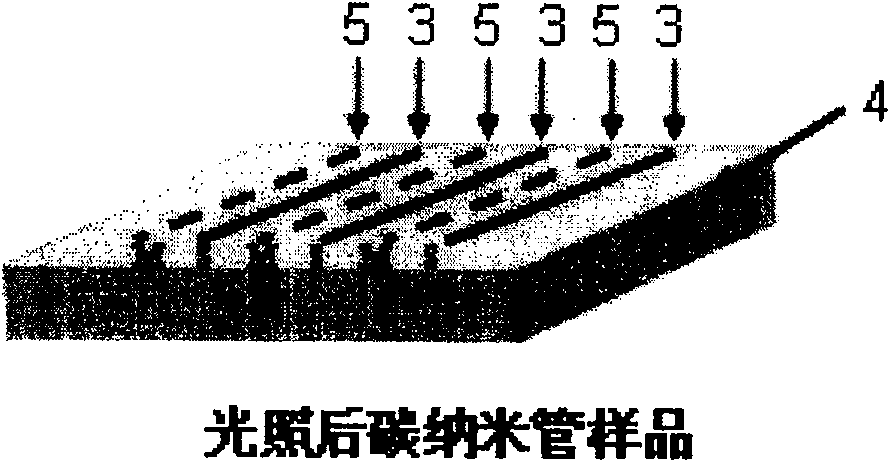Method for preparing semi-conductive single-walled carbon nanotubes
A single-walled carbon nanotube, semiconducting technology, which is applied in the field of preparing semiconducting single-walled carbon nanotubes, can solve the problems of complex processing, carbon nanotube damage, difficult application, etc., and achieve simple equipment, original appearance, and low cost Effect
- Summary
- Abstract
- Description
- Claims
- Application Information
AI Technical Summary
Problems solved by technology
Method used
Image
Examples
Embodiment 1
[0020] (1) A high-density array of single-walled carbon nanotubes oriented along the sapphire [1-100] lattice direction is grown on the surface of an A-plane sapphire single crystal by chemical vapor deposition (CVD). See attached figure 2 (a).
[0021] (2) Use a long-arc xenon lamp to illuminate the single-walled carbon nanotube array sample, and keep the surface light intensity of the single-walled carbon nanotube sample at 75mW / cm 2 , in the air for 60 minutes. See attached figure 2 (b).
[0022] (3) For 39 points in the same region on the same sample, corresponding to different illumination times (0min, 30min, 60min), respectively use Raman spectra with laser wavelengths of 633nm and 514nm for characterization. See attached figure 2 (c), attached figure 2 (d).
[0023] attached by figure 2 It can be seen that after 30 minutes of light irradiation, the Raman signal (M) of metallic single-walled carbon nanotubes in the single-walled carbon nanotube array decreas...
Embodiment 2
[0025] (1) Using chemical vapor deposition (CVD) to grow high-density single-walled carbon nanotubes on a silica substrate. See attached image 3 (a).
[0026] (2) Use a long-arc xenon lamp to illuminate the single-walled carbon nanotubes, and keep the surface light intensity of the single-walled carbon nanotubes at 75mW / cm 2 , lighted in the air for 30min. See attached image 3 (b).
[0027] (3) For 39 points in the same area on the same sample, corresponding to different illumination times (0min, 30min, 60min), use the Raman spectrum with a laser wavelength of 633nm to characterize, and use the Raman spectrum with a laser wavelength of 514nm to illuminate The samples after 60 min were characterized. See attached image 3 (c).
[0028] attached by image 3It can be seen that after 30 min of light irradiation, the Raman signal (M) of metallic single-wall carbon nanotubes in single-wall carbon nanotubes decreases sharply; after 60 min of light irradiation, in the single...
Embodiment 3
[0030] (1) Using chemical vapor deposition (CVD) to grow high-density single-walled carbon nanotube arrays on the A-plane sapphire single crystal substrate, and transfer the single-walled carbon nanotube arrays to the carbon dioxide on a silicon substrate. See attached Figure 4 (a).
[0031] (2) Use a long-arc xenon lamp to illuminate the single-walled carbon nanotube array sample, and keep the surface light intensity of the single-walled carbon nanotube sample at 75mW / cm 2 , in the air for 120min.
[0032] (3) The samples after irradiating for 120 min were characterized by Raman spectrum with a laser wavelength of 633 nm. See attached Figure 4 (b).
[0033] attached by Figure 4 It can be seen that after 120min of light irradiation, the Raman signal (M) of the metallic single-walled carbon nanotubes is very little (160cm -1 -230cm -1 ), mainly the Raman signal (S) of semiconducting single-walled carbon nanotubes (-1 area). It can be seen that after 120 minutes of l...
PUM
| Property | Measurement | Unit |
|---|---|---|
| strength | aaaaa | aaaaa |
Abstract
Description
Claims
Application Information
 Login to View More
Login to View More - R&D
- Intellectual Property
- Life Sciences
- Materials
- Tech Scout
- Unparalleled Data Quality
- Higher Quality Content
- 60% Fewer Hallucinations
Browse by: Latest US Patents, China's latest patents, Technical Efficacy Thesaurus, Application Domain, Technology Topic, Popular Technical Reports.
© 2025 PatSnap. All rights reserved.Legal|Privacy policy|Modern Slavery Act Transparency Statement|Sitemap|About US| Contact US: help@patsnap.com



